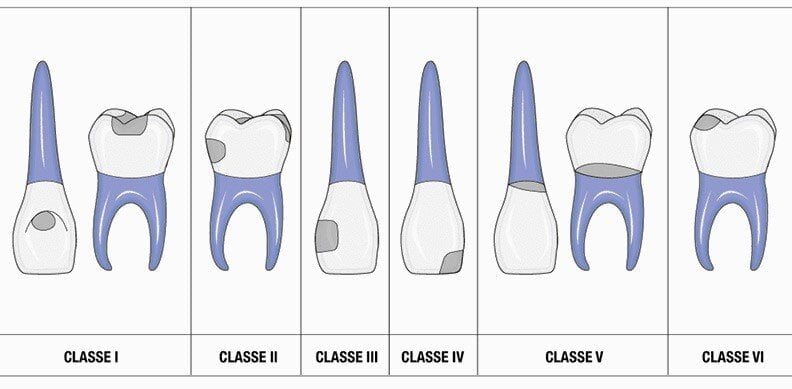Tooth cavities, also known as dental caries or decay, are a common dental problem that affects people of all ages. They occur when bacteria in the mouth produce acids that erode the tooth enamel, leading to the formation of holes or cavities. The classification of tooth cavities helps dentists diagnose and treat decay effectively. In this comprehensive guide, we will explore the classes of tooth cavities, their characteristics, and the recommended treatment options for each class.
Table of Contents
ToggleClass I Cavities
Class I cavities are the most common type and occur on the chewing surfaces of the back teeth (molars and premolars) and the front teeth (incisors and canines). These cavities typically form in the pits and fissures of the teeth, where food particles and bacteria can accumulate. Class I cavities are often small and can be treated with simple fillings.
Treatment:
The treatment for Class I cavities involves removing the decayed portion of the tooth and filling the cavity with dental materials such as amalgam, composite resin, or glass ionomer cement. The choice of filling material depends on factors such as the location of the cavity, esthetic concerns, and patient preferences.
Class II Cavities
Class II cavities occur on the sides or surfaces between the back teeth (molars and premolars). These cavities are commonly caused by inadequate oral hygiene, improper brushing techniques, and the accumulation of plaque and bacteria in the interproximal areas. Class II cavities can be larger and may require more extensive treatment compared to Class I cavities.
Treatment:
The treatment for Class II cavities involves removing the decayed portion of the tooth and restoring the cavity with dental fillings. The choice of filling material depends on various factors, including the size and location of the cavity, patient preferences, and the dentist’s recommendation. Amalgam and composite resin fillings are commonly used for Class II cavities.
Class III Cavities
Class III cavities occur on the surfaces between the front teeth (incisors and canines). These cavities are often caused by poor oral hygiene, plaque buildup, and acidic food and drink consumption. Class III cavities can be challenging to detect and may lead to cosmetic concerns if left untreated.
Treatment:
The treatment for Class III cavities involves removing the decayed portion of the tooth and restoring the cavity with dental fillings. Composite resin fillings are the preferred choice for Class III cavities due to their ability to match the natural color of the teeth. The dentist will carefully shape and polish the filling to ensure a seamless blend with the surrounding tooth structure.
Class IV Cavities
Class IV cavities are similar to Class III cavities but involve both the interproximal surfaces (between the front teeth) and the biting edge or incisal edge of the tooth. These cavities can significantly impact the tooth’s structural integrity and esthetics.
Treatment:
The treatment for Class IV cavities is similar to Class III cavities and involves removing the decayed portion of the tooth and restoring the cavity with composite resin fillings. The dentist will carefully shape and contour the filling to restore the natural shape and appearance of the tooth.
Class V Cavities
Class V cavities occur on the tooth’s smooth surfaces, particularly near the gum line. These cavities are often caused by factors such as gum recession, improper brushing techniques, and acidic food and drink consumption. Class V cavities can be sensitive and may lead to tooth sensitivity and discomfort.
Treatment:
The treatment for Class V cavities involves removing the decayed portion of the tooth and restoring the cavity with dental fillings. Depending on the size and location of the cavity, the dentist may recommend composite resin fillings or glass ionomer cement. In some cases, if the cavity is extensive or close to the gum line, a dental crown may be necessary to provide additional support and protection to the tooth.
Class VI Cavities
Class VI cavities are relatively rare and occur on the incisal edges or biting surfaces of the front teeth and the cusp tips of the back teeth. These cavities are typically caused by excessive wear and tear, tooth grinding (bruxism), or abrasive tooth brushing.
Treatment:
The treatment for Class VI cavities depends on the extent of the damage and may include dental fillings, dental bonding, or dental crowns. The choice of treatment will be determined by the dentist after a thorough examination and evaluation of the tooth.
Conclusion
Understanding the classification of tooth cavities is essential for effective diagnosis, treatment, and prevention of dental decay. Different classes of cavities require specific treatment approaches based on the location, size, and severity of the decay. Regular dental check-ups and maintaining good oral hygiene practices, such as brushing and flossing, are crucial in preventing cavities and preserving oral health. Remember, early detection and prompt treatment of cavities can help prevent further damage and the need for more extensive dental procedures. If you suspect the presence of a cavity or experience tooth sensitivity or pain, it is essential to schedule a dental appointment for proper evaluation and appropriate treatment.

